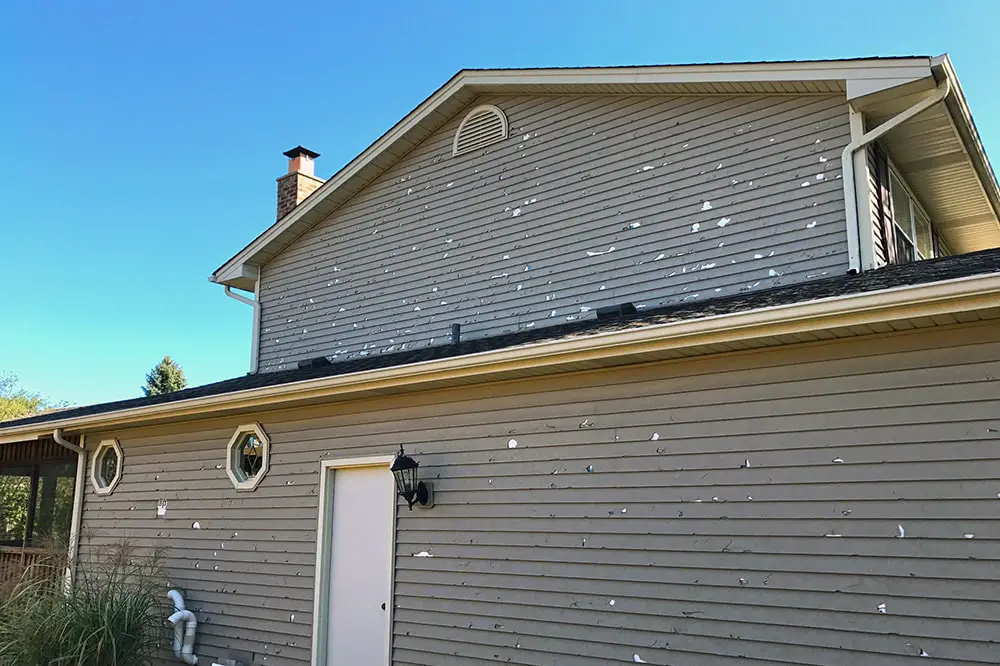Hail damage is the most common claim in America according to the Insurance Information Institute. Hail can cause significant damage to a roof or other parts of homeowners house and other property. A Homeowners policy may or may not cover the homeowner in the event of hail damage. There are a number of nuances that may lead to a covered claim or may lead to a denied claim depending on the situation.
- Standard homeowners insurance policies normally cover hail damage, but coverage can differ across locations.
- High-risk areas for hail damage may have more limited coverage and/or higher premiums than in other areas.
- Older roofs and cosmetic damage caused by hail are typical exclusions or more limited in coverage in a home insurance policy.
When does home insurance cover hail damage?
Under a standard home insurance policy such as HO-3 or HO-5 coverage, hail damage is normally included as a covered peril. This means that typically damage to the home’s structure, other structures, or the homeowner’s personal belongings will be covered in the event of hail being the cause of the damage. If the homeowner has to relocate to a hotel while their roof is being repaired due to hail damage, that additional living expense would also be covered. Even injuries to someone on the property and the medical bills that come with those injuries may be covered under the home insurance policy if the hail was the cause of the injury.

How much the home insurance policy covers and what it covers can vary drastically from location to location around the country. Hail damage is one of the perils that can be covered but the coverage differs widely from state to state or city to city. States in the Midwest part of the country where hail and hail damage are common occurrences have more limited hail damage coverage in the standard home insurance policy or possibly more stipulations on what constitutes a covered claim in the policy.
While there are coverage variations for hail damage, it is almost always covered to some extent under a standard policy, no matter the location of the home.
Limitations to hail damage coverage in higher-risk areas
Hail damage has increasingly become a more and more common occurrence in some parts of the country. According to the National Weather Service, the top five states for the number of hail events in 2022 were: Texas, Nebraska, Minnesota, Kansas, and South Dakota. This is actually a shifting trend that has appeared as weather patterns have changed over the years. Historically states like Colorado and Wyoming have been included in the top five with Texas, Nebraska, and Kansas. This trend may cause insurers in those states that are seeing higher amounts of hail and hail damage to modify their home insurance policies to better suit the changing occurrence of the peril. This may lead to higher premiums for new homeowners in those states. The dollar amount of damage caused by hail has increased significantly in recent years as well, leading to higher insurance premiums and more limited coverage for some homeowners.
There are a few different limitations or cost-off-setting measures that insurance companies implement to reduce their exposure to hail damage claims in higher-risk areas for the peril. These measures include exclusions for cosmetic damage, lower coverage limits for hail damage, deductibles for wind and hail, and outright exclusion of wind or hail as a covered peril.

Exclusions for cosmetic damage
Cosmetic damage in this instance means damage to the appearance of a roof, window, door, chimney, or any other part of a house, but no damage to the functionality of the home’s structure at all. Some homeowners insurance providers in some areas around the country have begun adding in this exclusion for cosmetic damage to further protect themselves in the event of hail. It is a very nuanced type of exclusion that leads to fewer covered claims under the standard home insurance policy.
Make sure to read through your policy and check with your insurance agent to determine if this exclusion is in your policy or not. This is especially important for homeowners in the Midwestern states that see numerous hailstorms every year.
Lower coverage limits when it comes to hail damage
Some insurance providers will pay lower claims for hail damage to a roof or other part of the home that is older and more worn down already. If a homeowner has a roof that is 15 or more years old, the insurance company will most likely reimburse the replacement cost of the roof on an actual cash value basis which takes into account depreciation in the value of the roof over time. This leads to a lower reimbursement amount to the homeowner. Some insurers may even simply state a lower coverage limit for hail damage whether the home is older or not.
Deductibles for wind and hail
Some insurance companies have begun implementing deductibles for wind and hail damage within their home insurance policies. These deductibles work similarly to health insurance deductibles. How a deductible works is that there is a specified deductible amount that the homeowner is responsible for before the insurance company will pay out in the event of a covered claim. For example: say a hailstorm comes through and causes $5,000 of damage to your roof and your deductible for hail damage is $1,000. This means that the first $1,000 of damage is on you, the homeowner to pay for. Once the deductible has been satisfied by you, the insurance company will pay the remaining $4,000, subject to the maximum amount of coverage provided in the policy.
Another form of deductible that some companies have implemented in especially high-risk areas is percentage-based deductibles. The percentages are in relation to the insured value of the home. The percentages typically range from one percent to five percent. The way percentage deductibles work is say your home is insured for $300,000 and you have a 2% wind and hail deductible. A hailstorm comes through and causes damage to the home, you as the homeowner are responsible for the first $6,000 ($300,000 x 2%) of damage before the insurer will pay out.
These deductibles are typically offered by insurance providers as endorsements on a policy to keep the premium cost to the homeowner lower. A homeowner may choose not to put the endorsement on the policy, which will lead to a higher premium cost for greater protection. There are many states that require a deductible for wind or hail damage and some may require a specific form of deductible.
Outright exclusion of wind or hail
Some insurers will even give homeowners the opportunity to take a step further, by outright excluding wind or hail damage from being covered in the policy. Obviously, this will lead to a lower premium for the homeowner, but could potentially open them up to a very costly bill in the event of wind or hail damage. This outright exclusion is not usually recommended unless the homeowner has a significant fund for unexpected expenses in place, that can cover damage repair costs.
Hail damage statistics
As mentioned at the start of this article, according to the Insurance Information Institute, hail and wind damage are the most common damage claims in the country with roughly 2.3 claims out of every 100 homes. This totals out to between 6 and 7.5 million houses filing wind or hail damage claims. The number of claims has fluctuated up and down over the years but has steadily trended upward especially in recent years.
Wind and hail tend to be one of the more costly forms of damage with over $13-$15 billion in damage per year in recent years. This is a number that has increased significantly over the years as well as weather patterns have changed, and hailstorms have become more frequent.

Home insurance claim process for hail damage
As wind or hail damage can cause severe damage to a home or other structures on the property and potentially lead to leaks in a roof or other issues that may make the home unsafe or unusable, it is important to file a claim and get those repairs completed as soon as possible. Below are the steps to filing a claim and ensuring an efficient claims process so the damage can be repaired as soon as possible.
- Document the damage. Make sure to take many photographs of the damage and possibly measure the size of the hail if you’re able to. Good photo evidence can greatly help in having a claim covered and covered expediently.
- Submit the claim. Talk with your insurer and submit your claim as soon as you can. Make sure to do your best to describe the damage and provide photo evidence in order to get the most benefit out of the claim. You can help expedite your claim submission by having your policy number ready.
- Meet with the insurance adjuster. After the claim is submitted, you will need to schedule a meeting with an insurance adjuster to inspect the hail damage and make an assessment that will be provided to the insurance company. After the assessment has been completed and provided to the insurance company, the company will determine whether the claim is accepted or denied and if accepted, to what extent the company will pay out. Something that may help your claim chances and expedite the claim and repair process, is to get a few repair estimates from local licensed contractors prior to the insurance adjuster coming out to inspect the damage. Insurance companies may try to negotiate a very low claim award to support their bottom line.
- Hire a local contractor to repair the damage. After the claim has been approved, you can then hire a contractor to complete the repair work of the damage caused by the wind or hail. It is important to note how insurers typically pay out the actual claim. The insurance provider typically pays out half the award amount in order for the repairs to begin and then will pay the other half out after the repairs have been completed. The monetary award process may even be further complicated by the insurance company making the check out to not only you but the company that your mortgage is through if you have one. This will lead to an extra step of working with the mortgage company to get the money allocated out to the contractor for repairs to occur.
Filing a claim for hail damage may lead to higher insurance premiums in the future. Normally, one claim doesn’t lead to any increase, but two claims certainly will. With this in mind, if hail damage occurs and it is insignificant or could be repaired easily and cheaply, it may make more sense to simply pay out of pocket to have repairs completed or repair the damage yourself.
Hail damage, home insurance, and cars
Hail notoriously causes damage to cars. Unfortunately, under a home insurance policy, a homeowner’s car is not covered for hail damage. Damage to one’s car due to hail can be covered by a comprehensive auto insurance policy though. Comprehensive auto coverage is an optional coverage that may be worthwhile to have if you live in a hail-prone area.
Summary
Hail damage is common, it is costly and leads to nuanced distinctions by insurance providers. Hail damage is an expensive claim for insurers which has led them to provide minute distinctions between what is covered and not covered along with various ways that they try to reduce their exposure to hail damage losses. When filing a claim make sure to be thorough in your own documentation and take the necessary steps to ensure that you are made whole for the damages caused to you. If you are living in a hail-prone area, the additional premium expense for greater coverage may be worthwhile to give you the peace of mind that you are protected.

